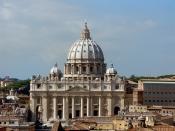St. Peters Basilica St. Peters basilica In the Middle of the 15th century it was becoming very evident that the Old St. Peters Basilica was in a bad state. By this time it was more than a thousand years old. Pope Nicholas V began some foundations for a remodeling of the choir space, but after his death in 1455 nothing more was done until the election of Julius II in 1503. The original intent of Julius II was to continue propping up the old basilica and to rebuild only where necessary. Rebuilding instead of starting new was heavily favored by Julius II because he did not want to interfere with the sacredness of the site . But on the other hand, Julius II was dealing with the Roman Catholic Church's wants of staying ahead of the World in the budding renaissance architecture scheme.
Given that old St. Peters Basilica was such a remarkable piece of Christianity, this whole situation could have easily been dealt with by preserving the old basilica by creating an immense structure surrounding it.
Therefore the old basilica would not have to have been destroyed in order for a new larger basilica.
Nevertheless, by 1506 Julius II had acquired the architect Bramante to help him design a new plan for a new building, which would replace the tattered St. Peters Basilica. The plan they had originally come up with, imitated the Greek cruciform plan of the old basilica, yet bigger. Throughout the 16th century there was controversy over the final form in which the church would be built; the centralized Greek cruciform plan or the shape of a Latin cross. The Latin cross plan designs for a more formal and longer nave for processions, while the Greek cruciform plan symbolizes the alter in a more formal manner.


